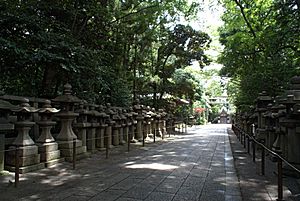Kōshō facts for kids
Kōshō was a special time period in Japanese history. It was a "year name" or nengō (pronounced NEN-goh). This era came after the Kyōtoku period and before the Chōroku period. The Kōshō era lasted from July 1455 to September 1457. During these years, Emperor Go-Hanazono was the ruler of Japan.
Key Moments of the Kōshō Era
- 1456 (Kōshō 2): The leader of Japan, called the shogun (pronounced SHOW-gun), visited the Iwashimizu Shrine. Many important government officials, who were part of the Daijō-kan (a top government council), joined him at the shrine. This was an important event for the court.
- 1456 (Kōshō 2): The father of Emperor Go-Hanazono passed away. He was 85 years old.
Related Pages
External Links
- National Diet Library, "The Japanese Calendar" -- a look at Japanese history through its calendar, with pictures from the library's collection

All content from Kiddle encyclopedia articles (including the article images and facts) can be freely used under Attribution-ShareAlike license, unless stated otherwise. Cite this article:
Kōshō Facts for Kids. Kiddle Encyclopedia.
